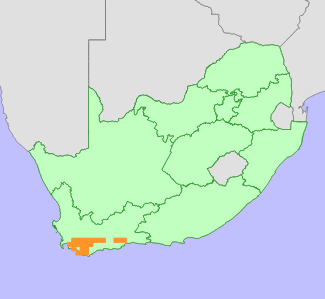|
Scientific Name | Protea subulifolia (Salisb. ex Knight) Rourke |
Higher Classification | Dicotyledons |
Family | PROTEACEAE |
Synonyms | Protea acerosa R.Br. |
Common Names | Awl-leaf Sugarbush (e) |
National Status |
Status and Criteria | Least Concern |
Assessment Date | 2020/03/02 |
Assessor(s) | A.G. Rebelo, H. Mtshali & L. von Staden |
Justification | Protea subulifolia is a widespread and common species, with an extent of occurrence (EOO) of 17 121 km² and an area of occupancy (AOO) of 732 km². It is declining in parts of its range, but it is not yet in danger of extinction. It is therefore assessed as Least Concern. |
Distribution |
Endemism | South African endemic |
Provincial distribution | Western Cape |
Range | This species is endemic to the Western Cape Province of South Africa, where it occurs from the Du Toit's Kloof Mountains to the Riviersonderend Mountains, the lower slopes of the Dwarsrivier Mountains south of Grabouw, and the central Langeberg between Robertson and Heidelberg. Isolated subpopulations occur on the Agulhas Plain around Elim, and in the western Outeniqua Mountains between Cloete's Pass and Robinson Pass. |
Habitat and Ecology |
Major system | Terrestrial |
Major habitats | North Outeniqua Sandstone Fynbos, South Langeberg Sandstone Fynbos, North Langeberg Sandstone Fynbos, South Sonderend Sandstone Fynbos, North Sonderend Sandstone Fynbos, Hawequas Sandstone Fynbos, Greyton Shale Fynbos, Elgin Shale Fynbos, Robertson Granite Fynbos, Boland Granite Fynbos, Elim Ferricrete Fynbos, Western Coastal Shale Band Vegetation |
Description | It occurs in variable habitats, including sandy places and heavy clay soils on mountain slopes and flats, 100-1500 m. Mature individuals are killed by fires, and only seeds survive. Wind-dispersed seeds are stored in fire-resistant inflorescences, and released after fires. It is pollinated by rodents. |
Threats |
| Around Elim, this species is threatened by habitat loss to agriculture. Most remaining subpopulations in this area occur on isolated remnants of Elim Ferricrete Fynbos among crop fields. On the southern slopes of the Riviersonderend Mountains, it has lost habitat in the past to timber plantations, and is currently threatened by competition from escaped pine seedlings that have spread into native fynbos vegetation adjacent to plantations, and is now impenetrable in places. In the Langeberg, there has also been past habitat loss to plantations, and some subpopulations are also threatened by competition from alien invasive plants. In the Palmiet River Valley, it has lost habitat to fruit orchards, and sporadic loss is continuing. Currently, about 17% of this species' habitat is irreversibly modified, predominantly around Elim and in the Bot River Valley between Kleinmond and Hawston. |
Population |
This is a widespread and common species. The Protea Atlas Project (1996-2001) recorded more than 40 subpopulations. Most subpopulations are large, consisting of more than 1000 mature individuals. A continuing decline is inferred from ongoing habitat loss and degradation.
|
Population trend | Decreasing |
Notes |
| Isolated subpopulations on the Agulhas Plain and in the western Outeniqua Mountains are thought to be distinct taxa, but they have not been formally recognised. If these were to be separated from P. subulifolia, both are likely to be threatened, but P. subulifolia in the strict sense is not threatened. |
Assessment History |
Taxon assessed |
Status and Criteria |
Citation/Red List version | | Protea subulifolia (Salisb. ex Knight) Rourke | Least Concern | Raimondo et al. (2009) | |
Bibliography |
Goldblatt, P. and Manning, J.C. 2000. Cape Plants: A conspectus of the Cape Flora of South Africa. Strelitzia 9. National Botanical Institute, Cape Town.
Manning, J.C. and Goldblatt, P. 2012. Plants of the Greater Cape Floristic Region 1: The Core Cape Flora. Strelitzia 29. South African National Biodiversity Institute, Pretoria.
Raimondo, D., von Staden, L., Foden, W., Victor, J.E., Helme, N.A., Turner, R.C., Kamundi, D.A. and Manyama, P.A. 2009. Red List of South African Plants. Strelitzia 25. South African National Biodiversity Institute, Pretoria.
Rebelo, T. 2001. Sasol Proteas: A field guide to the proteas of southern Africa. (2nd ed.). Fernwood Press, Vlaeberg, Cape Town.
|
Citation |
| Rebelo, A.G., Mtshali, H. & von Staden, L. 2020. Protea subulifolia (Salisb. ex Knight) Rourke. National Assessment: Red List of South African Plants version 2024.1. Accessed on 2025/12/02 |
 Comment on this assessment
Comment on this assessment

